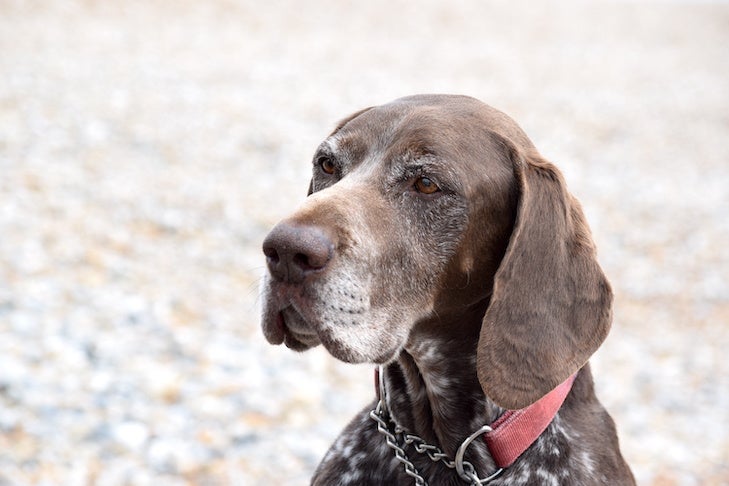
We all want our dogs to live long, full lives, but a dog’s senior years can present challenges. More frequent naps are no surprise, but aging dogs may deal with more serious conditions, such as chronic kidney disease or hearing loss. Physical decline isn’t the only concern in older dogs. What about your dog’s cognitive abilities? Can dogs get dementia? Unfortunately, dog dementia impacts many older dogs, and it’s basically the dog equivalent of Alzheimer’s disease in humans.
What Is Dog Dementia?
Dog dementia is also sometimes referred to as canine cognitive dysfunction, and it’s a condition that impacts your dog’s behavior and cognition (their ability to learn, remember, and perceive their environment). However, “canine cognitive dysfunction” isn’t the technically correct term. Dr. Sagi Denenberg, a veterinary behaviorist at North Toronto Veterinary Behaviour Specialty Clinic, explains that the term Cognitive Dysfunction Syndrome (CDS) in dogs is more accurate because we don’t know if any other animals in the canine family, like wolves and coyotes, suffer from the same condition.

Many other illnesses can look similar to the signs of CDS. For example, arthritis in dogs can lead to lower activity levels. That makes CDS a diagnosis of exclusion, meaning your veterinarian will need to rule out all other potential medical causes first. Therefore, it’s hard to know how common dog dementia actually is. But according to Dr. Denenberg, one study found that 28% of dogs between 11 and 12 years of age have at least one sign of dog dementia, and that increased to 68% in dogs over 15 years of age.
What Causes Cognitive Dysfunction in Dogs?
CDS is caused by changes in the brain that are linked to aging. One such change affects the brain’s neurons, which are the cells that relay information throughout the brain. If the neurons can’t work properly, the brain can’t do its job.
Dr. Denenberg offers a simplified explanation, saying, “The most common reason for CDS is similar to human Alzheimer’s disease. It is due to oxidative damage in the brain cells. This is partly due to poor blood circulation and less available oxygen and partly due to deteriorated oxygen metabolism in brain cells. These changes lead to toxic proteins—Tau protein and Amyloid. Overall, you have an increased death rate of neurons, particularly in the areas where memory is stored.” Those areas include the hippocampus, part of the brain involved in learning and making memories.
What Dog Dementia Symptoms Should You Watch For?
CDS affects older dogs, with signs beginning around nine years of age. But it progresses slowly, starting with only one or two signs before the dog shows full-blown indicators. The most common signs are covered by the acronym “DISHA.” That includes the following behaviors:
- Disorientation: A disoriented dog will look confused. For example, they might get stuck in a corner, wander aimlessly, or walk towards a door and wait to be let out on the hinge side rather than the side that opens.
- Interactions: Your dog’s social relationships with people and other pets will be affected. They might become clingy where they used to be independent or become aloof where they were once friendly.
- Sleep-Wake Cycle: Your dog’s sleep patterns will change. They might sleep more during the day, but mostly they will start waking in the night.
- House Soiling: Your dog might begin to poop and pee in the house. Dr. Denenberg explains this is a key example of the forgetfulness caused by CDS. “Owners may not notice when their dog forgets to eat sometimes or forgets known signals. But they will always notice a dog who forgets to let them know it needs to go out.”
- Activity: Your dog’s activity levels will shift. They may become more active and restless or may become lethargic when they were once quite energetic.

Sometimes you will see two more letters added to the acronym, making it DISHAAL. The extra “A” refers to anxiety. Dogs with CDS can develop new fears, become clingy, and vocalize more, all due to increased nervousness.
And the final “L” indicates issues with learning and memory. Your dog might forget how to perform behaviors you had previously taught them, learn new behaviors more slowly, or be unable to adapt to change. It’s important to observe your dog for any of the above signs so you can take your dog to the vet for evaluation and start the recommended treatment as soon as possible.
What Is Sundowner Syndrome in Dogs With CDS?
Sundowner syndrome is a part of CDS’s sleep-wake cycle disturbance. Your dog might sleep more in the daytime, then become restless and agitated at night, similar to how a person with Alzheimer’s disease might have a flare-up of their condition in the evening. Your dog could pace, wander away, or bark for no reason. This can be disruptive to your sleep as well.
To help manage this aspect of your dog’s CDS, Dr. Denenberg suggests, “Owners should add mental and environmental enrichment and exercise. Ideally, these can be provided on a predictable schedule so the dog may remember and expect them. If the owners can provide it more during the day and especially use it as a pre-emptive tool, it may help with Sundowner syndrome.”
How Can You Treat Cognitive Dysfunction in Dogs?
Although the condition will progressively worsen and there is no cure, there are ways to help manage and slow CDS. For example, there are several medications available. One is selegiline, which is thought to slow down oxidative damage in the brain. Another is propentofylline, a drug that helps with blood circulation in the brain.
You can also talk to your veterinarian about supplements like SAMe (S-adenosylmethionine), vitamin E, and ginkgo biloba, which all act as antioxidants. Research has shown that adding antioxidants to a canine diet can help older dogs complete more difficult learning tasks, suggesting consuming them can result in improvements in cognitive function. Finally, don’t rule out dietary treatment for dog dementia. Diets rich in fish oils or medium chain triglycerides (MCTs), including two veterinary diets, have proven helpful.

It can be challenging to live with a dog with CDS, particularly if your dog is no longer friendly or poops in the house. And it’s hard to watch your dog’s quality of life decline. Many owners struggle with when to put down a dog with dementia.
But dogs with CDS can have full life spans. To help your dog with CDS live a happier life, Dr. Denenberg says providing mental and environmental enrichment is critical. “The brain is like a muscle—use it or lose it. So training, puzzle toys, and exercise are all essential. Of course, you must be realistic with your expectation. The key to remember is that success in training is not the goal. Exercising the brain is.”
This article is intended solely as general guidance, and does not constitute health or other professional advice. Individual situations and applicable laws vary by jurisdiction, and you are encouraged to obtain appropriate advice from qualified professionals in the applicable jurisdictions. We make no representations or warranties concerning any course of action taken by any person following or otherwise using the information offered or provided in this article, including any such information associated with and provided in connection with third-party products, and we will not be liable for any direct, indirect, consequential, special, exemplary or other damages that may result, including but not limited to economic loss, injury, illness or death.

